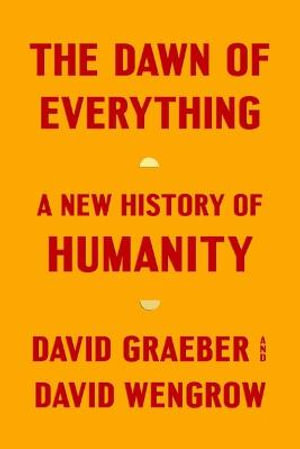Here is an extract from The Dawn of Everything (see previous post) that I feel at liberty to quote in full since Youtube programs of public discussions (see below) of the book show co-author David Wengrow reading this section in full to his audiences:
If there is a particular story we should be telling, a big question we should be asking of human history (instead of the ‘origins of social inequality’), is it precisely this: how did we find ourselves stuck in just one form of social reality, and how did relations based ultimately on violence and domination come to be normalized within it?

Perhaps the scholar who most closely approached this question in the last century was an anthropologist and poet named Franz Steiner, who died in 1952. Steiner led a fascinating if tragic life. A brilliant polymath born to a Jewish family in Bohemia, he later lived with an Arab family in Jerusalem until expelled by the British authorities, conducted fieldwork in the Carpathians and was twice forced by the Nazis to flee the continent, ending his career – ironically enough – in the south of England. Most of his immediate family were killed at Birkenau. Legend has it that he completed 800 pages of a monumental doctoral dissertation on the comparative sociology of slavery, only to have the suitcase containing his drafts and research notes stolen on a train. He was friends with, and a romantic rival to, Elias Canetti, another Jewish exile at Oxford and a successful suitor to the novelist Iris Murdoch – although two days after she’d accepted his proposal of marriage, Steiner died of a heart attack. He was forty-three.
The shorter version of Steiner’s doctoral work, which does survive, focuses on what he calls ‘pre-servile institutions’. Poignantly, given his own life story, it is a study of what happens in different cultural and historical situations to people who become unmoored: those expelled from their clans for some debt or fault; castaways, criminals, runaways. It can be read as a history of how refugees such as himself were first welcomed, treated as almost sacred beings, then gradually degraded and exploited, again much like the women working in the Sumerian temple factories. In essence, the story told by Steiner appears to be precisely about the collapse of what we would term the first basic freedom (to move away or relocate), and how this paved the way for the loss of the second (the freedom to disobey). It also leads us back to a point we made earlier about the progressive division of the human social universe into smaller and smaller units, beginning with the appearance of ‘culture areas’ (a fascination of ethnologists in the central European tradition, in which Steiner first trained).
What happens, Steiner asked, when expectations that make freedom of movement possible – the norms of hospitality and asylum, civility and shelter – erode? Why does this so often appear to be a catalyst for situations where some people can exert arbitrary power over others? Steiner worked his way in careful detail through cases ranging from the Amazonian Huitoto and East African Safwa to the Tibeto-Burman Lushai. Along the journey he suggested one possible answer to the question that had so puzzled Robert Lowie, and later Clastres: if stateless societies do regularly organize themselves in such a way that chiefs have no coercive power, then how did top-down forms of organization ever come into the world to begin with? You’ll recall how both Lowie and Clastres were driven to the same conclusion: that they must have been the product of religious revelation. Steiner provided an alternative route. Perhaps, he suggested, it all goes back to charity.
In Amazonian societies, not only orphans but also widows, the mad, disabled or deformed – if they had no one else to look after them – were allowed to take refuge in the chief’s residence, where they received a share of communal meals. To these were occasionally added war captives, especially children taken in raiding expeditions. Among the Safwa or Lushai, runaways, debtors, criminals or others needing protection held the same status as those who surrendered in battle. All became members of the chief’s retinue, and the younger males often took on the role of police-like enforcers. How much power the chief actually had over his retainers – Steiner uses the Roman Law term potestas, which denotes among other things a father’s power of arbitrary command over his dependants and their property – would vary, depending how easy it was for wards to run away and find refuge elsewhere, or to maintain at least some ties with relatives, clans or outsiders willing to stand up for them. How far such henchmen could be relied on to enforce the chief’s will also varied; but the sheer potential was important.
In all such cases, the process of giving refuge did generally lead to the transformation of basic domestic arrangements, especially as captured women were incorporated, further reinforcing the potestas of fathers. It is possible to detect something of this logic in almost all historically documented royal courts, which invariably attracted those considered freakish or detached. There seems to have been no region of the world, from China to the Andes, where courtly societies did not host such obviously distinctive individuals; and few monarchs who did not also claim to be the protectors of widows and orphans. One could easily imagine something along these lines was already happening in certain hunter gatherer communities during much earlier periods of history. The physically anomalous individuals accorded lavish burials in the last Ice Age must also have been the focus of much caring attention while alive. No doubt there are sequences of development linking such practices to later royal courts – we’ve caught glimpses of them, as in Predynastic Egypt – even if we are still unable to reconstruct most of the links.
Steiner may not have foregrounded the issue, but his observations are directly relevant to debates about the origins of patriarchy. Feminist anthropologists have long argued for a connection between external (largely male) violence and the transformation of women’s status in the home. In archaeological and historical terms, we are only just beginning to gather together enough material to begin understanding how that process actually worked.
Some online discussions:
British Library Event
(19 October 2021)
Brooklyn Public Library Event
(11 November 2021)
LSE Online Event
(16 October 2021)
Neil Godfrey
Latest posts by Neil Godfrey (see all)
- Questioning the Hellenistic Date for the Hebrew Bible: Circular Argument - 2024-04-25 09:18:40 GMT+0000
- Origin of the Cyrus-Messiah Myth - 2024-04-24 09:32:42 GMT+0000
- No Evidence Cyrus allowed the Jews to Return - 2024-04-22 03:59:17 GMT+0000
If you enjoyed this post, please consider donating to Vridar. Thanks!

